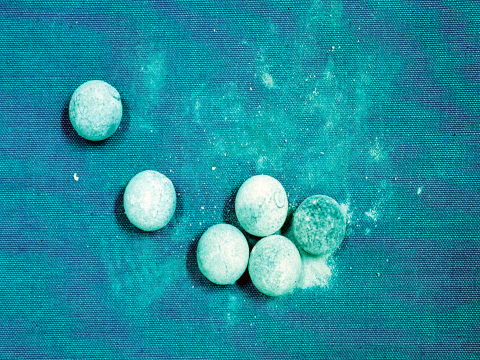Lead and Pewter
Lead is a soft grey metal that easily conforms to desired shapes and surfaces. In the past it was used for water storage and transmission through pipes. In combination with tin it forms pewter. Due to toxicity problems associated with the use of pewter food vessels the lead in pewter was replaced in the 18th century with antimony and some copper. Modern ‘leadless pewters’ are usually alloyed tin (Britannia metal).
Deterioration
Lead and pewter are prone to attack from acetic acid and other organic acid vapours given off by poor quality papers, some fabrics and various woods (Figure 5). The main corrosion product formed on lead and pewter not affected by organic acid vapours is white-grey, basic lead carbonate. This provides a deep, protective patina to the metal surface and should not be removed.
Figure 5: Lead musket balls with surface corrosion caused by exposure to organic acid vapours while displayed in a plywood display cabinet.
If pewter and lead have been in a low oxygen environment and exposed to sulphide compounds, a rich lustrous grey-black patina of metal sulphides forms on the surface. These minerals are stable and should not be removed.
Both tin and lead are very soft and susceptible to denting, tearing and scratching. Handle carefully.
Preventive Conservation
Adhere to the general guidelines described in the introduction to this chapter.
As lead and pewter objects are particularly susceptible to attack by organic acids emanating from certain woods, storage or display in enamelled metal cupboards is very important. If silicon sealants are used to assemble glass display cabinets for example, then ensure they are neutral cure and not acetic curing types.
Treatments
Cleaning
Do not remove the stable patinas that form on lead and its alloys, the white-grey lead carbonate and the dark lead sulphide, as they form a protective layer that prevents further corrosion. Other corrosion products may require treatment.
Carry out general cleaning in the following way:
- wash with warm water and a pure soap;
- rinse the object with fresh water. Do not soak in distilled water however as it will corrode lead;
- wipe with methylated spirits;
- polish with a soft cloth; and
- apply a protective surface coating of microcrystalline wax if necessary.
As it is difficult to obtain very mild abrasives, their use is not generally recommended on soft metals. If however, the white bloom that forms on the surface of these metals (lead or tin acetate) is thin, and one micron grade alumina powder is available, use a slurry of this alumina in water as a polish to remove the deposit from the surface.
If the white acetate layer is pustular or thick it is best removed by either electrochemical techniques or chemical reduction. These specialised techniques require the skills of a conservator.
Thin layers of corrosion products can be removed by soaking the objects in a solution of disodium ethylenediaminetetraacetic acid (EDTA, 50 g in 1 L of water). Avoid prolonged soaking as the dissolved oxygen in the solution will accelerate corrosion.













